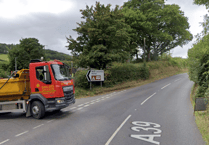Background information relating to the two articles written by Tim Taylor in the West Somerset Free Press
When did the West Saxons take possession of Carhampton and is there supporting evidence of Viking presence in the area?
Around 660 AD the West Saxon king Cenwalh defeated the Celtic British at the Battle of Peonnum, possibly Penselwood on the current Somerset/Wiltshire border, and chased them to the River Parrett, though that doesn’t necessarily mean that the West Saxon/British border remained there or that Saxons poured into the area at that time. Carhampton to the west of the River Parrett would have remained Celtic/Dumnonian.
In 710 AD the West Saxon, King Ine, is in possession of Taunton but in the hundred or so years following there is some evidence of a Celtic/British fightback and a more stable border.
During this period the West Saxon Kingdom of Wessex had its own internal problems and was dominated by the Kingdom of Mercia to the north. Did Carhampton remain Dumnonian during this period or did it become West Saxon? We do not know. But we do know that in circa 815 AD the West Saxon King Egbert (or Ecgberht) ravaged ‘the whole of the territory of the remaining British kingdom of Dumnonia’ and in 825 AD was campaigning in Dumnonia again. How much of this was permanent conquest at that time is uncertain.
In 825 AD Egbert defeated the Mercians at the Battle of Ellandun, possibly near Swindon. In 829 AD he became overlord of Mercia and signed a treaty at Dore, until recently in Derbyshire but now in Sheffield, but then in Mercia on the border with the then Anglo-Saxon Kingdom of Northumbria.
It seems that at Dore the King of Northumbria acknowledged Egbert as a type of overlord, which means that Egbert, from unpromising beginnings, was for a brief period the acknowledged overlord of the ‘English’ from the Channel to the Firth of Forth. The current Secondary School at Dore is named ‘King Ecgbert School’ and the treaty at Dore is celebrated by a modern stone on the Green at Dore, which contains an engraved Wyvern, the symbol of Wessex. Such is the fame of Egbert.
A Viking connection with Carhampton?
The Viking era is quoted as beginning with the 793 AD sacking of the monastery of Lindisfarne in Northumbria but there is evidence Vikings were trading with France in the late 6th Century and were almost certainly trading with Britain by the 8th Century.
Evidence of their presence in the Bristol Channel is found in the Old Norse names of the islands ‘Lundy’, meaning Puffin Island, and ‘Holm’ meaning small island in an estuary or inlet, eg ‘Steep Holm’ and ‘Flat Holm’, and also ‘holms’ off the Pembrokeshire coast. That these names became engrained in local use suggests that the Vikings interacted with people resident on the Bristol Channel coast in social and/or verbal exchange.
In the early 9th Century the Vikings were present in Dumnonia. In 836 AD Egbert and then in 840 his son King Ethelwulf fought the Danes at Carrum (Carhampton), with the Danes holding the field, which means the Danes won! Were the Danes in alliance with Dumnonian inhabitants of Carhampton or were they invading West Saxon Carhampton?
In 838 AD at the Battle of Hengestdun, identified as current Hingston Down just into current Cornwall above the River Tamar, Egbert defeated an alliance of British (Cornish) and ‘a great ship army’ of Vikings, thus effectively ending over a hundred years of warfare between the West Saxons and Dumnonians.
If the West Saxons were not in possession of Carrum before 838 AD, they would have been soon after. William of Malmesbury reports negotiations between King Alfred of Wessex and King Dungwith of Cornwall in circa 876 AD, held somewhere near Exmoor in Devon (!), possibly to secure either Cornish neutrality or even alliance against the Vikings.
So what might the Danes have been doing in Carrum in 836 AD and 840 AD? If they had been carrying-out some form of hostile raid of the Minster and settlement, they would not have remained long enough for Egbert to organise his soldiers to cross the difficult land approaches to Carrum, and the Danes with their longships and highly developed seamanship would have commanded the Bristol Channel.
Also, there seem to be no records of Vikings (Danes) pillaging or invading the Dumnonian territories at that time; their relationship with the Dumnonians seems to be one of alliance against Wessex and/or mutual trading.
The Danes would have needed reliable bases on the Bristol Channel coast, in order to trade, and obtain food, shelter and materials essential for living. They could not have lived only at sea in their longships. They would have needed wood to build or repair longships and iron for weapons and axes to cut wood. Carrum would have been an ideal base for them, providing food from fertile land, wood, shelter, iron from iron foundries and a beach on which to moor and repair their longships.
They would have been masters of the sea and semi-protected by the hills around. The inhabitants of Carrum would probably have been willing partners, no doubt being well-rewarded for their support and provision for their guests.
To maintain such a base without pillaging the Danes would have needed such local support. If the Danes were present in Carrum, how long were they there and did they form a more permanent settlement? The seeming failure of Egbert (836 AD) and Ethelwulf (840 AD) suggests that there might have been a more permanent Danish presence at Carrum in alliance with native British (Dumnonians).
For Egbert and/or Ethelwulf to assemble an army and travel to Carrum would have taken planning and time. This suggests that they knew the Danes would be at Carrum using it for a type of base and would not have disappeared elsewhere in the Bristol Channel in their longships.
Similarly the Danes must have had a reason to fight the West Saxons, rather than take to the sea in their longships. This suggests that the Danes had something to detain them at Carrum. Why would the Danes stay and fight unless they had something to fight for and why would Egbert and/or Ethelwulf have taken their armies to Carrum unless they expected a Danish presence there?




